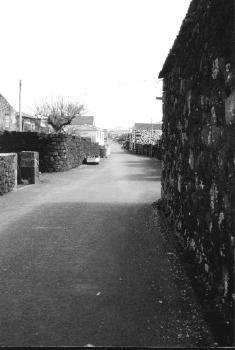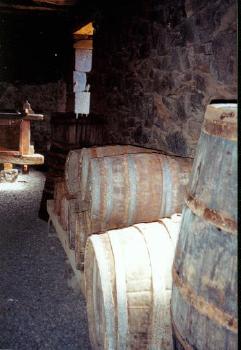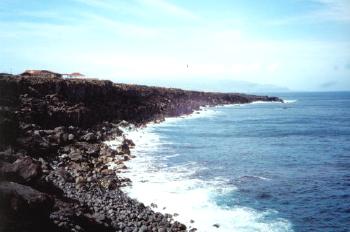Pico, The Azores (Açores), Portugal (March 2001)

Porto do Cachorro meets the sea on Pico’s northwestern coast (map). It is an old, traditional town with narrow streets along a rugged coastline of rapidly cooled lava flows. When people settle the island they naturally used locally available building materials. For Pico that meant charcoal-black volcanic rocks. Thus, the buildings and walls of these rural towns looked different than just about anywhere else in the Azores.
A History of Vineyards

Vineyards are common along this stretch of Pico’s coastline. Accordingly, the United Nations Educational, Scientific and Cultural Organization (UNESCO) added the “Landscape of the Pico Island Vineyard Culture” to its World Heritage Center list in 2004. UNESCO based this designation on “the adaptation of farming practices to a remote and challenging environment.”
Vignerons cellar their wine in a number of old stone sheds in Porto do Cachorro. Here they age their classic wine called “verdelho.” This style, technically an aperitif, does particularly well in the volcanic soils of Pico. They also use low stone walls to protect vines from the elements. This allows them to produce various red and white wines in addition to the more traditional style.
Once in decline, viticulture continues to grow in popularity on the island. One of the agricultural cooperatives produces a commonly available brand known as “Terras da Lava.”
Volcanic Terrain

A stretch of coastline just outside of town has an unusual name. They call it Arcos do Cachorro. Translated into English, that means literally “Arches of the Puppy.” So, that makes the town “Port Puppy.” The name may come from a nearby rock formation that resembles the muzzle of a dog.
The entire area sits atop on an old lava flow. Hot magma and cool ocean water reacted vigorously to produce tunnels, caves, arches, rocks and all sorts of unusually twisted coastal features.
Articles in The Azores Series
- Index of All Islands Visited
- The Island of Pico

Leave a Reply